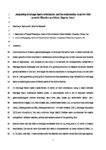Analyzing drainage basin orientation and its relationship to active fold growth (Handun anticline, Zagros, Iran)
| dc.contributor.author | Bahrami, S | |
| dc.contributor.author | Stokes, M | |
| dc.date.accessioned | 2023-02-13T15:35:08Z | |
| dc.date.available | 2023-02-13T15:35:08Z | |
| dc.date.issued | 2023-04-01 | |
| dc.identifier.issn | 1872-695X | |
| dc.identifier.issn | 1872-695X | |
| dc.identifier.other | 108605 | |
| dc.identifier.uri | http://hdl.handle.net/10026.1/20303 | |
| dc.description.abstract |
Combinations of tectonic geomorphological criteria are frequently used to detect vertical and lateral growth of fold structures in tectonically active settings due to their low cost and relative ease of application. The purpose of this study is to analyze the morphometric properties of drainage basins developed into the flanks of a growing anticline to explore the active tectonic growth patterns of the fold. We target the Handun anticline in the Zagros Simply Folded Belt due to it being an actively growing fold structure with a high variability of drainage basin morphologies across different parts of the fold. 57 drainage basins were characterized in terms of their orientation using a newly defined drainage basin orientation (DBO) index, in combination with a set of standard tectonic geomorphological metrics (drainage basin area [Ba], slope [S], asymmetry factor [AF], hypsometric integral [HI], basin shape [Bs], crescentness index [CI], sinuosity of the main drainage [Smd], drainage density [Dd], drainage density of 1st-order streams [Dd1], drainage frequency [Df] and sinuosity of anticline divide [Sad]). Indices were synthesized for spatial comparison between western, central and eastern zones of the growing fold. Results show that the DBO is strongly correlated with its CI, Smd, and Ba. In terms of spatial distribution, the central zone is characterized by higher values of DBO, Ba, S, CI, Smd, and Sad. These contrast with the western and eastern zones (fold plunge regions), which are characterized by higher values of Dd, Dd1, and Df. Of note is the southern limb of the anticline, which is characterized by larger drainage basins, and higher values of AF, CI, and Smd. This suggests higher lateral erosion on the southern fold flank. In contrast, drainage basins with steeper S, and greater DBO and elongation are found on the northern limb, suggesting dominance of vertical erosion. This contrasting south-north erosion pattern suggests that the northern fold flank is actively steepening, and presenting a more youthful topography, with lower and spatially focused erosion that is increasing with time. Overall, high values of the newly proposed DBO metric relate to the presence of a curved and/or an asymmetric forked drainage pattern, and also to the trend of faults and fractures across the fold. These structures are typically oriented oblique to the fold axis, with further modification into a semi-annular drainage pattern developed around a salt diapir. | |
| dc.format.extent | 108605-108605 | |
| dc.language | en | |
| dc.language.iso | en | |
| dc.publisher | Elsevier | |
| dc.rights | Attribution-ShareAlike 4.0 International | |
| dc.rights.uri | http://creativecommons.org/licenses/by-sa/4.0/ | |
| dc.subject | Drainage basin orientation | |
| dc.subject | Tectonic geomorphological indices | |
| dc.subject | Folds | |
| dc.subject | Anticlines | |
| dc.title | Analyzing drainage basin orientation and its relationship to active fold growth (Handun anticline, Zagros, Iran) | |
| dc.type | journal-article | |
| dc.type | Journal Article | |
| plymouth.author-url | https://www.webofscience.com/api/gateway?GWVersion=2&SrcApp=PARTNER_APP&SrcAuth=LinksAMR&KeyUT=WOS:000927382700001&DestLinkType=FullRecord&DestApp=ALL_WOS&UsrCustomerID=11bb513d99f797142bcfeffcc58ea008 | |
| plymouth.volume | 426 | |
| plymouth.publication-status | Published | |
| plymouth.journal | Geomorphology | |
| dc.identifier.doi | 10.1016/j.geomorph.2023.108605 | |
| plymouth.organisational-group | /Plymouth | |
| plymouth.organisational-group | /Plymouth/Faculty of Science and Engineering | |
| plymouth.organisational-group | /Plymouth/Faculty of Science and Engineering/School of Geography, Earth and Environmental Sciences | |
| plymouth.organisational-group | /Plymouth/REF 2021 Researchers by UoA | |
| plymouth.organisational-group | /Plymouth/REF 2021 Researchers by UoA/UoA07 Earth Systems and Environmental Sciences | |
| plymouth.organisational-group | /Plymouth/Research Groups | |
| plymouth.organisational-group | /Plymouth/Research Groups/Marine Institute | |
| plymouth.organisational-group | /Plymouth/Users by role | |
| plymouth.organisational-group | /Plymouth/Users by role/Academics | |
| dcterms.dateAccepted | 2023-01-25 | |
| dc.rights.embargodate | 2024-3-31 | |
| dc.identifier.eissn | 1872-695X | |
| dc.rights.embargoperiod | Not known | |
| rioxxterms.versionofrecord | 10.1016/j.geomorph.2023.108605 | |
| rioxxterms.licenseref.uri | http://creativecommons.org/licenses/by-sa/4.0/ | |
| rioxxterms.type | Journal Article/Review |



